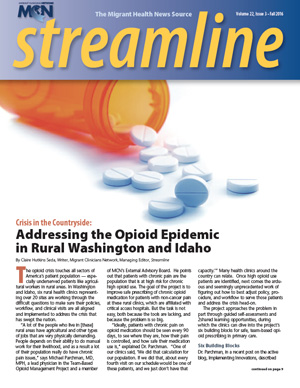Addressing the Opioid Epidemic in Rural Washington and Idaho
 By Claire Hutkins Seda, Writer, Migrant Clinicians Network, Managing Editor, Streamline
By Claire Hutkins Seda, Writer, Migrant Clinicians Network, Managing Editor, Streamline
The opioid crisis touches all sectors of America’s patient population — especially underserved patients like agricultural workers in rural areas. In Washington and Idaho, six rural health clinics representing over 20 sites are working through the difficult questions to make sure their policies, workflow, and clinical visits are all aligned and implemented to address the crisis that has swept the nation.
“A lot of the people who live in [these] rural areas have agricultural and other types of jobs that are very physically demanding. People depends on their ability to do manual work for their livelihood, and as a result a lot of their population really do have chronic pain issues,” says Michael Parchman, MD, MPH, a lead physician in the Team-Based Opioid Management Project and a member of MCN’s External Advisory Board. He points out that patients with chronic pain are the population that is at high risk for chronic high opioid use. The goal of the project is to improve safe prescribing of chronic opioid medication for patients with non-cancer pain at these rural clinics, which are affiliated with critical access hospitals. But the task is not easy, both because the tools are lacking, and because the problem is so big.
“Ideally, patients with chronic pain on opioid medication should be seen every 90 days, to see where they are, how their pain is controlled, and how safe their medication use is,” explained Dr. Parchman. “One of our clinics said, ‘We did that calculation for our population. If we did that, about every fourth visit on our schedule would be one of these patients, and we just don’t have that capacity.’” Many health clinics around the country can relate. Once high opioid use patients are identified, next comes the arduous and seemingly unprecedented work of figuring out how to best adjust policy, procedure, and workflow to serve those patients and address the crisis head-on.
The project approaches the problem in part through guided self-assessments and2shared learning opportunities, during which the clinics can dive into the project’s six building blocks for safe, team-based opioid prescribing in primary care.
Six Building Blocks
Dr. Parchman, in a recent post on the active blog, Implementing Innovations, described the six building blocks as “the core components of safe, team-based opioid prescribing that we have seen in primary care settings across the country.” The project’s website has its resources aligned with each of these building blocks, under “Resources and Tools”. Here’s a short summary of each of the six from the Implementing Innovations blog post. Visit the website at www.improvingopioidcare.org for more on each topic.
- Leadership and consensus: Build organization-wide consensus to prioritize safe, more selective, and more cautious opioid prescribing.
- Use a registry to proactively manage patients: Implement pro-active population management before, during, and between clinic visits of all chronic opioid therapy patients to ensure that care is safe and appropriate and to measure results of chronic opioid therapy improvement activities.
- Revise policies and standard work: Revise and implement clinic policies and define standard work for health care team members to achieve safer opioid prescribing and chronic opioid therapy management in each clinical contact with chronic opioid therapy patients.
- Planned, patient-centered visits: Through planned visits, conduct proactive population management before, during, and between clinic visits of all patients on chronic opioid therapy to ensure that care is safe and appropriate. Support patient centered, empathic communication for chronic opioid therapy patient care.
- Caring for complex patients: Develop policies and resources to ensure that patients who become addicted to opioids, or who develop complex opioid dependence, are identified and provided with appropriate care, either in the care setting or by outside referral.
- Measuring success: Continuously monitor progress and improve with experience.
Implementing the Building Blocks
The project assigned a clinic coach, someone who stays in touch with the clinics each month to provide technical assistance in implementing each of the building blocks. During that time, the clinics began reviewing their policies and procedures — which Dr. Parchman says can be a revealing process.
“A lot of the [clinics] already had some kind of patient agreement form, also known as a ‘pain contract,’” Dr. Parchman noted, but they often found “their policies weren’t in agreement with the patient agreement form,” and vice versa. Once they aligned the two, the clinics began to question the workflow in the clinic to make sure the policies are implemented. For most clinics, this unleashed a barrage of questions: Where do we get random urine drug tests done? Who’s going to check the state prescription database once or twice a year? Who’s responsible for checking to make sure that the patient agreement has been updated and signed in the past year during the clinic visit? Where does that workflow occur?
An additional challenge is determining what measures the clinic will use to track whether the care patients receive is improving and that their patients are actually getting better. “There are no validated measures out there, traditional quality measures,” Dr. Parchman explained. “So now, they’re struggling with how to measure success,” how to determine whether the added work that is being factored into the workflow is worth the time and effort.
In addition to a clinic coach, the clinics share questions and gain insight through shared learning opportunities, which include monthly phone-in discussions among the clinics to help them troubleshoot issues and share resources. During one recent call, the group discussed how to taper someone off of opioids, which sparked a number of questions: Is there a good protocol? How do you assess a patient’s willingness to taper off? Does anyone have an opioid tapering tool? When does someone qualify as a chronic opioid user?
The project also offers the clinics monthly webinars with the Director of Chronic Pain Management at the University of Washington, after which each clinic gets the opportunity to present a difficult case for discussion.
The project is about halfway through its 36-month grant from the Agency for Healthcare Research and Quality, at the end of which they hope to release a package of tools — but the project has created a number of resources that they’ve already released on the website. “We’re releasing tools and resources on the website as fast as we can,” Dr. Parchman explained, “Because it’s a crisis.”
Resources
- The project’s website, www.improvingopioidcare.org, is full of useful resources. Here are a few recommended by Dr. Parchman:
- Get tips on how to navigate the difficult opioid conversation with patients by downloading “Opioid Patient Discussion Guidelines,” available on the Planned Patient-Centered Visits page: https://goo.gl/94nQ78.
- “Revise Policies and Standard Work” features four resources to help health centers adjust their guidelines and treatment agreements: https://goo.gl/1wcj3Z.
- The US Surgeon General has called on clinicians to lead against the opioid crisis. Learn more and sign on at www.turnthetiderx.org/join.
- Read the Implementing Innovations blog post on the Six Building Blocks at https://goo.gl/qO8IcJ.
- The Clinician Consultation Center offers free, real-time clinician-to-clinician telephone consultation, focusing on substance use evaluation and management for primary care clinicians. With special expertise in pharmacotherapy options for opioid use, its addiction medicine-certified physicians, clinical pharmacists, and nurses provide advice based on Federal treatment guidelines, up-to-date evidence, and clinical best practices. Call 1-855-300-3595, 10:00am – 6:00pm, EST. For more information: http://nccc.ucsf.edu/clinician-consultation/substanceuse-management/
Read this article in the Fall 2016 issue of Streamline here!
Sign up for our eNewsletter to receive bimonthly news from MCN, including announcements of the next Streamline.
Return to the Streamline Fall 2016 Table of Contents.
